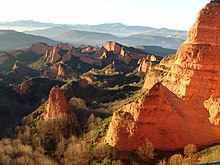Ruina montium
 From Wikipedia the free encyclopedia
From Wikipedia the free encyclopedia

Ruina montium (Latin, "wrecking of mountains") was an ancient Roman mining technique described by Pliny the Elder (Natural History 33.21), who served as procurator in Spain.[1][2] It is thought to draw on the principle of Pascal's barrel.[3] Miners would excavate narrow cavities down into a mountain, whereby filling the cavities with water would cause pressures large enough to fragment thick rock walls.[4][5][6]
See also[edit]
References[edit]
- ^ Pliny the Elder (1857) with John Bostock and H.T. Riley, trans., The Natural History of Pliny (London, England: Henry G. Bohn), vol. 6, Book 33, Ch. 21, pp. 101–104.
- ^ John F. Healy (1999). Pliny the Elder on Science and Technology. Oxford University Press. pp. 275–290. ISBN 978-0-19-814687-2.
- ^ Ancient Engineers' Inventions: Precursors of the Present (Springer, 2009), p. 135.
- ^ Rossi, Cesare; Russo, Flavio; Russo, Russo (2009). Ancient Engineers' Inventions. Vol. 8. Springer. pp. 133–141. ISBN 978-90-481-2252-3.
- ^ Cesare Rossi; Flavio Russo (26 August 2016). Ancient Engineers' Inventions: Precursors of the Present. Springer. pp. 185–192. ISBN 978-3-319-44476-5.
- ^ Alfred Michael Hirt (25 March 2010). Imperial Mines and Quarries in the Roman World: Organizational Aspects 27 BC-AD 235. OUP Oxford. pp. 32–45. ISBN 978-0-19-957287-8.